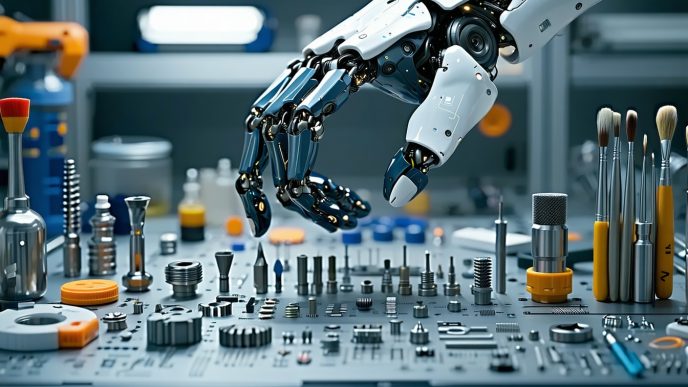Exploring Robot Manipulation Tasks
An Introduction to Robot Gripping and Manipulation
Robot manipulation tasks involve the ability of robots to grasp, move, and interact with objects, which is essential for many applications. Gripping and manipulation can vary from simple tasks, such as picking up an object, to more complex activities that require precision and coordination. Understanding the fundamentals of robot gripping and manipulation is crucial for those interested in the development and application of robotic technology.
The basic components of robotic manipulation include various types of end effectors, such as grippers, claws, or hands. Each type offers different capabilities and is suited for specific tasks. A table below outlines common robotic end effectors and their functionalities.
| End Effector Type | Description | Typical Use Cases |
|---|---|---|
| Grippers | Simple mechanical devices that open and close to grasp objects | Pick and place, assembly |
| Claws | Multi-fingered gripping systems that can adapt to object shapes | Manipulation of fragile objects |
| Robotic Hands | Dexterous mechanisms that replicate human hand movements | Fine motor tasks, surgery |
The Importance of Dexterity in Robotic Arms
Dexterity in robotic arms is a key factor that enhances the efficiency and versatility of robots. This skill allows robots to perform intricate tasks that require precision, such as assembling small components or handling delicate items. The design of dexterous robot hands often incorporates multiple joints and sensors to enable a wide range of motion and adaptability.
One crucial aspect of dexterity is the ability to apply varying degrees of force, known as gripping strength. Innovative developments in robot grasping technology have introduced mechanisms that enable robots to adjust their grip based on the object’s weight and fragility. Advanced systems often leverage tactile sensors in robot hands to provide feedback during manipulation, enhancing control and precision.
A comparison of different robots and their dexterity capabilities can be seen in the following table.
| Robot Type | Dexterity Level | Notable Features |
|---|---|---|
| Simple Gripper | Low | Limited movement, basic grasping |
| Medium Dexterity Robot | Medium | Multi-jointed arms, basic force control |
| High Dexterity Robot | High | Advanced manipulators with feedback sensors |
Understanding the factors influencing robotic dexterity, including gripping strength and adaptability, is central to the advancement of automation and robotic solutions. Resources on adaptive gripping in robots offer insights into how innovative approaches are shaping the future of robotic manipulation. This knowledge is essential for anyone eager to explore the future of robotic manipulation.
Simple Manipulation Tasks
Robots are increasingly capable of performing simple manipulation tasks that serve as foundational operations in various applications. These tasks are primarily focused on basic handling of objects and are vital for building more complex functionalities.
Basic Pick and Place Operations
One of the most common tasks carried out by robots is the pick and place operation. This simple task involves the robot identifying an object, gripping it, and subsequently placing it in a designated location. Pick and place operations are essential in manufacturing, warehousing, and assembly lines.
The efficiency of pick and place tasks depends on several factors such as the robot’s gripping mechanism, speed, and precision. The following table outlines some typical specifications observed in modern robotic systems performing pick and place operations:
| Specification | Description |
|---|---|
| Gripping Strength | Average of 5 to 15 Newtons |
| Speed of Operation | 1 to 2 seconds per task |
| Precision | ± 1 mm |
| Average Cycle Time | 60 to 120 tasks per hour |
This task is often supported by advanced technologies such as robot grasping technology, enhancing the robot’s ability to securely hold various object shapes and sizes.
Simple Object Stacking
Another straightforward task is object stacking, where robots arrange items in a vertical manner. This operation often serves as a precursor to more complex functions like sorting or assembling.
Robots utilize various strategies to achieve stable stacking, including algorithms for balancing and alignment. Typical parameters for robots engaged in stacking tasks are shown in the following table:
| Specification | Description |
|---|---|
| Maximum Stack Height | Up to 2 meters |
| Stability Factor | 80% effective with stable base |
| Cycle Time for Stacking | 45 to 90 seconds per stack |
| Common Objects Used | Boxes, trays, and containers |
Stacking tasks benefit greatly from adaptive gripping in robots, which allows for adjustments based on the material properties of the objects being handled.
Understanding these basic robot manipulation tasks, such as pick and place operations and simple stacking, lays the groundwork for comprehending more advanced manipulation techniques and applications. Insights into dexterous robot hands and how robots interact with objects can further illuminate the capabilities of robotic systems in various contexts. For those interested in the future of these advancements, the article on the future of robotic manipulation delves into ongoing innovations in this field.
Medium Complexity Tasks
In the realm of robotics, medium complexity tasks involve manipulations that require a level of precision and adaptability beyond basic operations. These tasks are crucial for applications where robots must interact with various components or items, showcasing their versatility and effectiveness.
Assembling Components
One of the key tasks robots can perform with their arms is assembling components. This often requires robots to manipulate multiple pieces accurately, positioning them correctly before fastening or securing them together. This capability is commonly seen in manufacturing environments, such as automotive assembly lines, where robotic arms are responsible for putting together various parts of a vehicle.
The efficiency of a robot’s component assembly can be influenced by several factors, including speed and precision. Below is a table showcasing typical specifications associated with assembly tasks:
| Specification | Value |
|---|---|
| Speed (components per minute) | 60 – 120 |
| Precision (mm) | ±0.01 – ±0.05 |
| Gripping Strength (N) | 10 – 50 |
| Tool Change Time (seconds) | 5 – 15 |
For more information on how robots grip and manipulate objects in assembly, refer to our article on robot gripping and manipulation.
Sorting Items by Shape or Size
Another essential medium complexity task is sorting items by shape or size. Robots equipped with advanced sensors and vision systems can identify the characteristics of different objects. This sorting task is critical in distribution centers and recycling facilities, where efficient organization of items is necessary.
Robots can utilize various methods for sorting, including machine learning algorithms to improve their accuracy in recognizing shapes and sizes over time. Below is a table illustrating standard metrics related to sorting capabilities:
| Specification | Value |
|---|---|
| Sorting Speed (items per minute) | 100 – 250 |
| Accuracy Rate (%) | 90 – 99 |
| Minimum Object Size (cm) | 2 – 5 |
| Sensor Type | Camera, Laser |
For insights into the technology behind robotic sorting, you can explore our resource on tactile sensors in robot hands or delve into adaptive gripping in robots for understanding how robots adjust their grip based on the item being sorted.
Medium complexity tasks are pivotal in demonstrating how robots can perform valuable functions within various industries. As the capabilities of robotic arms continue to evolve, these tasks will become increasingly efficient, highlighting the future potential in the field of robotic manipulation. For a broader view of what lies ahead, check out our article on the future of robotic manipulation.
Complex Manipulation Tasks
Robots are becoming increasingly adept at performing complex manipulation tasks. These tasks often require fine motor skills and the ability to follow multi-step processes, which are critical for certain applications.
Fine Motor Skills for Delicate Objects
Fine motor skills in robotic arms are essential for handling delicate items like electronic components, glassware, and medical instruments. These tasks require a high level of precision and control to ensure that the items are not damaged during manipulation.
Robotic arms equipped with advanced gripping technology can achieve delicate movements. They often utilize tactile sensors that provide feedback on pressure and position, allowing the robot to adjust its grip accordingly. This feedback system enhances the robot’s ability to perform tasks requiring finesse.
The following table provides a comparison of different levels of dexterity in robotic arms:
| Robot Type | Level of Dexterity | Ideal Applications |
|---|---|---|
| Basic Robot Arm | Low | Simple pick-and-place tasks |
| Dexterous Robot Hand | High | Fine motor tasks like surgical operations |
| Multi-Fingered Robot | Very High | Manipulating delicate objects, precise assembly |
For a deeper understanding of how robots grip and manipulate objects, explore our article on robot gripping and manipulation.
Multi-Step Assembly Processes
Multi-step assembly processes are some of the most complex robot manipulation tasks. These tasks often require a sequence of actions that must be performed in a specific order, such as assembling electronic devices or furniture components.
Robots designed for these processes typically incorporate adaptive gripping technology, which allows them to modify their grip depending on the object they are handling. This adaptability is crucial for ensuring that various components can be assembled efficiently without errors.
The table below outlines the steps commonly involved in a multi-step assembly process:
| Step Number | Task Description | Required Tooling |
|---|---|---|
| 1 | Picking up a component | Adaptive gripper |
| 2 | Aligning the component | Vision system for alignment |
| 3 | Assembling with another part | Tool attachment for merging |
| 4 | Confirming assembly | Tactile feedback system |
To learn more about how robotic arms use tools and techniques in assembly, refer to our article on robot tool usage.
Understanding these complex manipulation tasks enhances insights into the future of robotics. For more information on advancements in this area, visit our article on the future of robotic manipulation.
Specialized Manipulation Abilities
Robotic arms possess specialized manipulation capabilities that significantly enhance their functionality in various fields. Two prominent areas include medical applications and handling hazardous materials.
Medical Applications of Robotic Arms
Robotic arms are transforming the field of medicine by providing precision and improving surgical outcomes. These machines can perform intricate tasks that require exceptional dexterity. They are particularly useful in minimally invasive surgeries where precision is crucial.
Key Benefits of Robotic Arms in Medicine:
| Feature | Description |
|---|---|
| Precision | High accuracy in delicate procedures |
| Stability | Reduced tremors during operations |
| Enhanced Visualization | 3D imaging and magnified views |
| Minimal Invasion | Smaller incisions and quicker healing |
Robots are often equipped with tactile sensors in robot hands that enhance their ability to feel and manipulate tissue delicately. Additionally, these arms can be programmed for specific tasks, such as suturing, cutting, or even assisting in complex procedures like robotic-assisted prostatectomy. Understanding robot grasping technology is essential, as it plays a vital role in performing medical tasks effectively.
Handling Hazardous Materials
In industries that deal with dangerous substances, robotic arms offer a safe solution for handling hazardous materials. Robots designed for these tasks can protect human workers from exposure to toxic chemicals, radioactive materials, or biological hazards.
Key Features of Robotic Arms for Hazardous Material Handling:
| Feature | Description |
|---|---|
| Remote Operation | Allows operators to control robots from a safe distance |
| Robust Design | Built to withstand harsh conditions and environments |
| Adaptive Gripping | Capable of adjusting grip strength based on object requirements |
Robots equipped with gripping strength in robots can effectively manage different weights and shapes of hazardous objects. Using these specialized robotic arms ensures safety and efficiency in environments where human intervention would be dangerous. They are critical in sectors such as nuclear waste management and chemical processing plants.
These specialized manipulation abilities demonstrate the versatility and effectiveness of robotic arms across various applications, from healthcare to industrial safety. Exploring the future of these technologies can lead to further advancements in how robots perform complex robot manipulation tasks.
Challenges in Robot Manipulation
Robotic arms are designed to engage in various robot manipulation tasks. However, several challenges can hinder their effectiveness. Key challenges include the development of accurate sensing and feedback systems and the intricate process of programming complex movements.
Sensing and Feedback Systems
Sensing technology is essential for robots to interact effectively with their environment. Robots must accurately perceive their surroundings to perform tasks without errors. Advanced sensors provide crucial data that enables robots to understand object sizes, shapes, weights, and surface textures. Commonly used sensors include:
| Sensor Type | Description |
|---|---|
| Camera Systems | Capture visual data for object recognition |
| Lidar Sensors | Measure distances using laser beams |
| Force Sensors | Detect pressure applied during gripping |
| Tactile Sensors | Provide feedback on surface texture |
The use of these sensors facilitates adaptive gripping in robots, which allows them to adjust their grip based on the object’s characteristics. For more information about how these sensors work, see our article on tactile sensors in robot hands.
Programming Complex Movements
Programming is a critical aspect of robotic manipulation. Robots must be programmed to perform specific tasks, which can involve intricate sequences of movements. This can be a challenging process due to the following factors:
- Multistep Processes: Some tasks require a series of coordinated actions. Each movement must be precisely timed to ensure success.
- Dynamic Environments: Robots often operate in environments where objects can change positions or where unforeseen obstacles may arise.
- Learning Algorithms: Implementing machine learning can allow robots to improve their performance over time. However, it requires extensive programming and testing.
The complexity of programming can impact the robot’s effectiveness in performing tasks requiring fine motor skills. For an in-depth look at the role of programming in robotic tasks, refer to our article on robot tool usage.
Both the development of advanced sensing and the complexity of programming movements are crucial to enhancing robotic manipulation capabilities. Addressing these challenges will pave the way for more effective and versatile robots in various applications, including those discussed in our article on the future of robotic manipulation.















